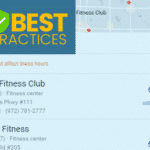There’s nothing like shopping for a new health club to remind you of the member perspective.
I recently noticed a small neighborhood fitness center near my home here in Dallas. My husband and I have worked out at hospital fitness centers, community fitness centers, a workout room in our condo building, a small JCC and a big YMCA, and a huge newly-built location of a national chain.
However, we’d prefer a small, well-equipped and friendly neighborhood spot. I was thrilled when I saw this place and predisposed to like it.
Here’s my take as a prospect, followed by my take as a wellness business expert:
My take as a prospective customer
The first (and only) person I met was at the front desk.
Much like Wal-Mart, the first (and only) employee I met was basically simply a friendly greeter. She wasn’t very knowledgeable about fitness or wellness. It was clear that our life experiences were entirely different, so we didn’t have much to say to each other. There was certainly no sense of “Great – she really gets it!”
She asked me what brought me in. I said I saw them as I was driving by – and that was it. No follow-up questions about my lifestyle, fitness goals, prior experiences, or what mattered to me in choosing a fitness center.
My reaction: Disappointment. I really expected someone knowledgeable, because this place presents itself as a perfect fit for people who are really into fitness and wellness.
We took a tour and played “Can you spot the equipment?”
She walked me through their storefront facility, pointing out the cardio equipment, the free weights and selectorized equipment, and the group fitness/yoga studio. She said the owners were wonderful people who really cared about all the customers. She said the customers were wonderful people who loved it there.
My reaction: The obligatory tour of the equipment doesn’t do much for me. I know what it all is, so unless there’s something unusual that’s worth pointing out, I’m more interested in getting a feel for the people who run the place and the people who patronize it. If all I care about is equipment, I can join 24 Hour or Lifetime or Gold’s. Boredom is always a problem, so I did notice that the TVs are shared – …bummer. I was a little surprised that no owners or managers were around, so I didn’t pay much attention to the comments about them. Plus, the comment about great customers sounded suspiciously like her description of the owners. She didn’t seem to know any of the customers who were there working out, so with no specifics, I didn’t take it very seriously.
I had questions. Answers, not so much.
They didn’t have a pull-up machine or a pull-up bar anywhere, so I asked about alternative ideas. She had one suggestion that wasn’t really practical and then we moved to the next tour stop.
My reaction: I think this is a reasonable question. She should have gotten a good answer while I was there, or followed up afterwards.
Since they only have a few pieces of cardio equipment, I was concerned about having to wait to use the equipment at certain hours. I was also concerned about availability of weight equipment for solo exercisers when trainers are working with clients. She wasn’t sure, but didn’t think it would be a problem. It was clear that she didn’t really know – and she didn’t find out, either. I also asked about the ratio of men/women and the ages, but she wasn’t sure.
My reaction: These are all basic questions and she should know the answers. Plus, these are important issues to me – when I didn’t get encouraging responses, my interest started dwindling fast.
She gave me a sales kit (and I almost fainted).
These five sales tools were in the pocket folder of marketing material she handed me at the end of the tour:
1) Group fitness and yoga class schedule
My reaction: Gosh, there sure are a lot of empty time slots…but that’s OK, because I don’t usually choose group fitness classes.
2) Hours of operation
Monday through Thursday, 5 a.m. to 9:30 p.m., Friday 5 – 8, Saturday 7 – 5, Sunday 8 – 5.
My reaction: Not good. I’m not an early bird. I love working out in the evening, so short weekend hours and Friday hours are a problem. Plus, closing at 9:30 during the week means they’ll be starting to clean up around me, and I hate feeling rushed. Too bad they can’t make a special arrangement for me, or offer 24-hour card access since it’s a pretty limited membership. Or maybe they could make a special arrangement — but I’m sure she wouldn’t know about it.
3) A sales pitch for personal training
It’s a flyer with extremely general goals and benefits, like “mass building”, “invariable results” and “efficiency”.
My reaction: I don’t even know what these terms really mean — it just sounds like marketing fluff. And there’s nothing on here about their credentials, their expertise, no pictures or testimonials from happy clients, no case studies, and no details about their programs or approaches. Would they just assign me randomly to a trainer? What if I want a female trainer, or one with a rehab background?
If personal training were high on my list, this would not motivate me to choose this business. Plus, do they only do training during their normal hours? Seems like it would get crowded pretty fast. I don’t like crowds and working out elbow-to-elbow.
4) Another marketing flyer
This flyer’s one long single-spaced paragraph stating that they have a “state of the art” facility with a “warm and luxurious” environment.
My reaction: Whatever. Anyone can pat themselves on the back. I can tell the equipment is reasonably new — but certainly not state of the art. The facility is reasonably clean and well-organized, although bits of gear are huddled next to the baseboards throughout the main workout area and the group fitness area. But it’s certainly not luxurious. I write this flyer off as marketing fluff.
5) …And of course, a price sheet.
She quickly points out the prices and emphasizes that no one will call me after I leave.
My reaction: I nearly fainted. The first price you see on this page is over $500/month! Then I realized that this price includes twice-weekly personal training. Might be OK if the trainers were fabulous, but I hardly know anything about them, so $500 is not gonna happen.
Below that, the plain-vanilla price of $59/month appears.
My reaction: Hmmm. That’s awfully close to what the new Life Time charges — but Life Time has better hours and tons more equipment. I’d never have to wait there. They don’t have CardioTheater, but they do have more TVs. The front desk experience is about the same — unskilled and slightly courteous people who don’t really have any interest in me at all and probably won’t be there in six months.
If I loved the people here and the environment was genuinely warm and relaxing, it’d be worth it — I don’t use all the equipment that Life Time offers, and I could probably tweak my workout schedule. But….
Finally, there’s some additional pricing for yoga and something called “semi privates” (a term that’s meaningless to me as a customer), which makes it clear that the “unlimited group exercise classes” described in the membership actually aren’t unlimited. As a customer, I hate having to remember what’s extra and what’s included.
My take as a business advisor.
I see five major critical mismatches in this experience:
1) A mismatch between what they say they do and what they really do
They’re presenting themselves as a neighborhood fitness center when they’re really a personal training studio.
So they’re attracting prospective customers like me, who really want a health club or fitness center, only to disappoint us because they don’t do a great job of meeting our needs — no wait times for equipment, longer operating hours, etc.
The bottom line is that you need to understand what makes your business special and clearly communicate it.
2) A mismatch between their sales strategy and their pricing strategy
For $500+/month, I expect to talk to someone knowledgeable about fitness and wellness as soon as I walk in the door.
In fact, I’d like to visit with an owner or a manager — a realistic expectation in a facility this small and focused. I want to be convinced that they really understand the customer experience that I’m after. That experience goes beyond equipment. It includes appreciating the kinds of customers and staff I want to be around and the kind of atmosphere I want to experience each time I come in. For example, I’d love to hear that lots of clients have been there for years, because I want an environment where I can actually get to know people.
The bottom line is that your sales strategy needs to be well-matched to your pricing strategy. Inexperienced and unskilled staff are not effective salespeople for a high-end and relatively high-priced service.
3) A mismatch between their sales strategy and the highly individualized services they offer
Where’s the “personal” in personal training? One-on-one training is a highly personal service. I expect a consultative approach to matching me with the trainer best suited to my interests and temperament.
As far as I could tell, they’d simply assign me to someone who had available time. It’s as if you walked into a car dealership and they said “Well, we have this white two-door car over here. Pay the cashier on your way out.” That’s not how people buy cars! And it’s not a recipe for building a healthy personal training studio either. Few customers make this kind of investment without considerably more discussion.
The bottom line is that health and wellness programs and services are, in fact, the most personal buying decisions made by consumers. Successful wellness businesses match what consumers need and want to the most appropriate programs and services.
4) A mismatch between their sales strategy and their actual business and customers
They need to tailor their sales and marketing strategy to their business and their potential customers.
Instead, they’ve simply copied what they saw elsewhere. But effective sales tools anticipate the questions and concerns that your specific prospects are likely to have.
Specifically, they should:
- Overhaul the tour to focus on features, advantages and benefits of membership
- Post photos and detailed professional bios of all the trainers
- Provide extensive testimonials and case studies in the sales kit
- Rework the existing marketing documents so that they’re genuinely useful to potential customers
- Reformat the class schedules so that they don’t look so skimpy
- Rethink how they present their pricing and respond to pricing objections.
5) A mismatch between their business goals and their follow-up tactics
They SHOULD follow up with potential customers, instead of announcing proudly that you’ll never hear from them after your visit!
No, you shouldn’t hassle prospects and pressure them to sign up. But promising that you’ll never contact them is silly, especially if you choose to use someone inexperienced as your main contact with prospects. For example, I had several questions that someone knowledgeable could have easily handled.
And frankly, if you’re presenting a high-end service and you insist on using unskilled labor to greet potential customers, you should have skilled fitness or wellness professionals make follow-up contact with qualified prospects.
Moreover, use the face-to-face encounter with a prospect to actually engage them in conversation and solicit their reactions. She had no idea that most of my concerns even existed because we really weren’t having a conversation. Instead, it was a monologue where she pointed out the types of equipment and commented briefly on a few areas like personal training. So this ineffective sales process will probably never improve!
As I was leaving, sales kit in hand, she asked if I had any questions. At that point, I had so many doubts — and she seemed so unaware of them and unable to address them — that I simply said no and left.
That’s what most prospects will do if you haven’t shown them that you understand their needs and know how to meet them. They won’t volunteer their worries — they’ll just strike your business off the list and move on….and you’ll be left to wonder why so few prospects stick around.




